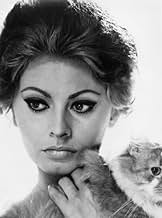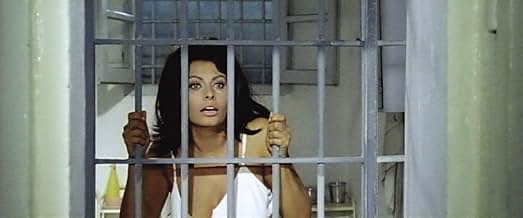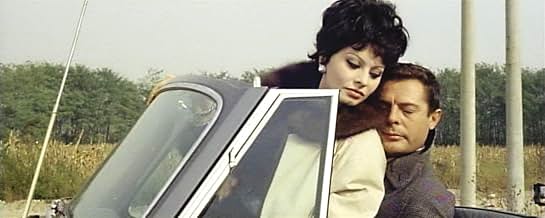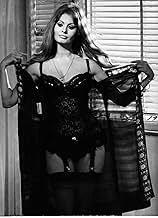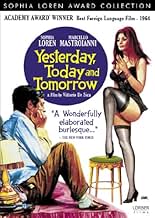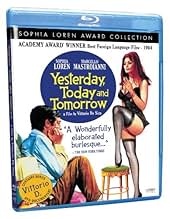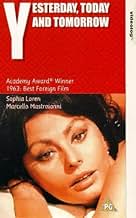NOTE IMDb
7,2/10
11 k
MA NOTE
Histoires sur trois femmes très différentes et les hommes qu'elles attirent.Histoires sur trois femmes très différentes et les hommes qu'elles attirent.Histoires sur trois femmes très différentes et les hommes qu'elles attirent.
- Réalisation
- Scénario
- Casting principal
- Récompensé par 1 Oscar
- 8 victoires et 3 nominations au total
Tonino Cianci
- (segment "Adelina")
- (as Antonio Cianci)
Gianni Ridolfi
- Umberto (segment "Mara")
- (as Giovanni Ridolfi)
Avis à la une
Italian anthology comedy starring Sophia Loren and Marcello Mastroianni. It's often cited as one of the best films of both stars. There are three stories involving different couples, each played by Loren and Mastroianni. The first has Sophia as a wife who keeps getting pregnant to avoid a jail sentence. It's an amusing story, although it goes on a little long. The second story is about a rich married woman taking a drive with her lover. The segment is pretty dull as it builds up to its punchline. But I suppose that was the point, to make you thing this was an inane soap opera story about whether this woman will choose fortune or love. The question is answered humorously enough but this is still the weakest story in the film. The third story, and the one for which the movie is probably most famous, has Sophia playing a prostitute. Her neighbor's grandson, about to become a priest, falls for Sophia and she must try to set him back on the right path. But, in doing so, she makes a vow that frustrates lustful client Marcello. Sophia's never looked sexier than here and her striptease is legendary.
Of the three stories, the last is the most entertaining but none are bad. Sophia is beautiful and enchanting. She and Marcello are both fun in every segment. It's an enjoyable film, though probably much more so if you are a big fan of Italian cinema to begin with.
Of the three stories, the last is the most entertaining but none are bad. Sophia is beautiful and enchanting. She and Marcello are both fun in every segment. It's an enjoyable film, though probably much more so if you are a big fan of Italian cinema to begin with.
These three stories very "Italian" indeed, are full of good humour, social observation and correct atmosphere. The direction of De Sica is superb, the acting of Mastroianni and Loren is unique and in the second and third stories we recognize the subtle and superior hand of their author, the great Zavattini. The first story takes place in a very typical popular neighbourhood of Naples where a cigarette pedlar and smuggler (Sofia Loren) discovers that the way of not going to jail for failing to pay a fine, is to get pregnant over and over and giving birth to one child after another with the problems this brings to her exhausted husband (Mastroianni). The second story shows us an aristocratic Milanese rich lady who to escape her boring life gets herself a lover on a social stratum lower to hers and finishes by valuing her Rolls Royce car more than her lover. This is perhaps the not so good of the three stories because it lacks some strength in terms of plot. Finally the third story (maybe the best of the three) is sometimes delirious and hallucinating in its very funny rhythm (Loren's acting is fabulous here) and tells us about a luxury prostitute living near the Piazza Navona in Rome who nevertheless has a soft heart and with whom a neighbour young seminarist falls in love while she plays a game of pull and let go with one of her clients who is anxious to take her to bed most unsuccessfully. This story has a surprising end and a fascinating scene of strip-tease (incomplete of course). You'll have a very amusing time watching this movie.
Two great performers of the Italian screen, Marcello Mastroianni and Sophia Loren, star in this earthy three-episode film, directed by Vittorio De Sica and tailor-made for the two stars. The success of this film led to the making of MARRIAGE, Italian STYLE a year later. In the first of the three comic vignettes Sophia is a black marketeer in Naples who discovers that a pregnant woman cannot be put in jail and so tries to maintain perpetual pregnancy. Poor fatigued husband Mastroianni is barely up to the task, however, and this fact provides much of the humor. The middle episode, the least effective, has Loren as a Milanese rich-bitch of liberal attitudes but who likes to plow into other people's cars. In the last episode Sophia is a Roman prostitute, Mastroianni is her sex-crazed customer. Part of the story is about how she unwittingly almost destroys the vocation of a seminarian living in an apartment across the terrace. Seminarians, surrender!
Addendum: in 2005 a new DVD release in letterbox format allows us to see the movie in its original wide-screen CinemaScope ratio. It has the original Italian language version with an English-tract option and a subtitle option.
Addendum: in 2005 a new DVD release in letterbox format allows us to see the movie in its original wide-screen CinemaScope ratio. It has the original Italian language version with an English-tract option and a subtitle option.
Yes, the stories are funny and heart-warming...all three of them. And Sophia Loren ALMOST makes you think she's as mean as the millionairess she portrays, talking of her 'humanity to man' while blowing all other cars off the road, bumping into them at stop signs and screaming at poor Marcello Mastroanni for crashing the Rolls rather than hitting a child. Knowing how long Sophia longed for a child, one felt great sympathy for her as she diapered her many children in order to stay out of jail. Italy had a law similar to the English' of 'pleading her belly' to which Sophia and Marcello conform through the births of seven children. The tale of the young priest, the prostitute and the increasingly frustrated 'client' is very well acted, and you can feel the mounting passion of poor Mastroanni as every act gets interrupted at the worst moment.
Of course, I love looking at the towns of Naples, Milan and Rome with all the old streets 'unspoiled' by the modernization of today. Check this one out for some excellent acting in widely divergent roles for both Loren and Mastroanni. No wonder the Museum of Fine Arts has Mastroanni festivals....one for Loren is equally called for. They both act with their eyes, their mouths and their entire bodies!!!
Of course, I love looking at the towns of Naples, Milan and Rome with all the old streets 'unspoiled' by the modernization of today. Check this one out for some excellent acting in widely divergent roles for both Loren and Mastroanni. No wonder the Museum of Fine Arts has Mastroanni festivals....one for Loren is equally called for. They both act with their eyes, their mouths and their entire bodies!!!
YESTERDAY, TODAY AND TOMORROW is a romantic comedy, which consists of three stories set in different parts of Italy. All three stories are framed in a romantic farce, which examines relationships through common life issues, such as poverty, adultery, sex and religion.
Stories about three very different women and the men they attract.
Adelina sells black-market cigarettes in Naples. Her husband is unemployed. She tries to avoid a jail sentence at any cost.
In Milan, Anna drives a Rolls, is bored, and picks up a writer, who is her lover. She talks dreamily of running off with him until he dents her car. After that, she shows her true face.
Mara, who works as a prostitute from her apartment in Rome, turns the head of a naive seminarian. After talking with his grandmother, she wants to help a young man, while her nervous client from Bologna impatiently waiting.
A male protagonist is exposed to tragicomic sobering, while a female protagonist is in a kind of inner conflicts, in each of the three stories. That's the point. The different characters of people are exposed to very strange situations, through which they question their relationships.
The scenery is very impressive, especially in the first story. That Neapolitan atmosphere in explosion of colors in a narrow streets is truly remarkable. The dialogues are, here and there, trivial and empty. Humor is somewhat forced, but it's pretty luscious. Characterization is not bad at all.
Sophia Loren (Adelina Sbaratti, Anna Molteni and Mara) is a temperamental and brave housewife, an elegant and selfish rich woman and a sensitive prostitute who would talk about morality. Yes, Ms. Loren looks divine in each of these women.
Marcello Mastroianni (Carmine Sbaratti, Renzo and Augusto Rusconi) is a fertile, but useless husband, a cautious lover and an impatient client, who can not accept the fact that he's in love with a beautiful prostitute. Mr. Mastroianni is mostly a muddled and confused character in each of the three stories.
I will say that this is another successful commedia all'italiana
Stories about three very different women and the men they attract.
Adelina sells black-market cigarettes in Naples. Her husband is unemployed. She tries to avoid a jail sentence at any cost.
In Milan, Anna drives a Rolls, is bored, and picks up a writer, who is her lover. She talks dreamily of running off with him until he dents her car. After that, she shows her true face.
Mara, who works as a prostitute from her apartment in Rome, turns the head of a naive seminarian. After talking with his grandmother, she wants to help a young man, while her nervous client from Bologna impatiently waiting.
A male protagonist is exposed to tragicomic sobering, while a female protagonist is in a kind of inner conflicts, in each of the three stories. That's the point. The different characters of people are exposed to very strange situations, through which they question their relationships.
The scenery is very impressive, especially in the first story. That Neapolitan atmosphere in explosion of colors in a narrow streets is truly remarkable. The dialogues are, here and there, trivial and empty. Humor is somewhat forced, but it's pretty luscious. Characterization is not bad at all.
Sophia Loren (Adelina Sbaratti, Anna Molteni and Mara) is a temperamental and brave housewife, an elegant and selfish rich woman and a sensitive prostitute who would talk about morality. Yes, Ms. Loren looks divine in each of these women.
Marcello Mastroianni (Carmine Sbaratti, Renzo and Augusto Rusconi) is a fertile, but useless husband, a cautious lover and an impatient client, who can not accept the fact that he's in love with a beautiful prostitute. Mr. Mastroianni is mostly a muddled and confused character in each of the three stories.
I will say that this is another successful commedia all'italiana
Le saviez-vous
- AnecdotesThe red car that picks up Mara after the accident is an extremely rare 1960 Ferrari 250 GT California Spyder SWB. Only 56 of these cars were made and some have sold for over $10M at auction in the 2010's.
- GaffesAs Anna and Renzo talk while driving, the windshield of her Rolls-Royce Silver Cloud II shakes because the little side windows are gone, but the little side windows are intact in the wide shots.
- Citations
Carmine Sbaratti: The people of Forcella are out of this world. They've risen up in a gesture of solidarity!
Verace's sister: I must say, it almost makes you forget how filthy and ignorant they are.
- ConnexionsEdited into Marcello, una vita dolce (2006)
Meilleurs choix
Connectez-vous pour évaluer et suivre la liste de favoris afin de recevoir des recommandations personnalisées
Détails
- Date de sortie
- Pays d’origine
- Langue
- Aussi connu sous le nom de
- Yesterday, Today and Tomorrow
- Lieux de tournage
- Piazza Navona, Rome, Lazio, Italie(3rd part - Mara's apartment)
- Sociétés de production
- Voir plus de crédits d'entreprise sur IMDbPro
- Durée1 heure 58 minutes
- Mixage
- Rapport de forme
- 2.35 : 1
Contribuer à cette page
Suggérer une modification ou ajouter du contenu manquant

Lacune principale
By what name was Hier, aujourd'hui et demain (1963) officially released in India in English?
Répondre

